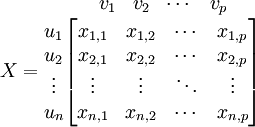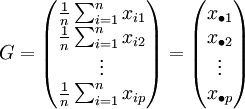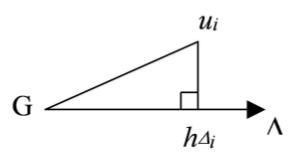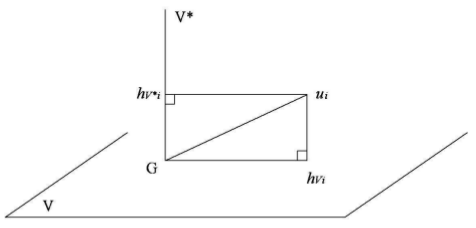M1 BBS ACP
From silico.biotoul.fr
m (→Choix de l'origine) |
m (→Recherche de \Delta_1 passant par G d'inertie minimum) |
||
| (2 intermediate revisions not shown) | |||
| Line 6: | Line 6: | ||
* grand nombre de variables que l'on cherche à visualiser en 2 à 3 dimensions | * grand nombre de variables que l'on cherche à visualiser en 2 à 3 dimensions | ||
* dessin de graphes | * dessin de graphes | ||
| - | |||
| - | |||
| - | |||
| - | |||
| - | |||
<math>\Rightarrow</math> '''Principe :''' trouver les axes sur lesquels on a un maximum de dispersion = plus de représentativité / moins de perte d'informations | <math>\Rightarrow</math> '''Principe :''' trouver les axes sur lesquels on a un maximum de dispersion = plus de représentativité / moins de perte d'informations | ||
| Line 76: | Line 71: | ||
</math> | </math> | ||
| - | == Mesure de dispersion | + | == Mesure de dispersion : Inertie == |
=== Inertie par rapport à un point (le centre de gravité) === | === Inertie par rapport à un point (le centre de gravité) === | ||
| Line 96: | Line 91: | ||
<math>\rightarrow</math> mesure la proximité du nuage des individus à l'axe. | <math>\rightarrow</math> mesure la proximité du nuage des individus à l'axe. | ||
| - | + | [[Image:projection.orthogonale.png]] | |
=== Inertie par rapport à un sous-espace vectoriel === | === Inertie par rapport à un sous-espace vectoriel === | ||
<math>I_V = \frac{1}{n} \sum_{i=1}^n d^2(h_{Vi}, u_i)</math> C'est pareil. | <math>I_V = \frac{1}{n} \sum_{i=1}^n d^2(h_{Vi}, u_i)</math> C'est pareil. | ||
| + | |||
| + | === Décomposition de l'inertie totale === | ||
| + | |||
| + | <math>V^*</math> le complémentaire orthogonal de <math>V</math> | ||
| + | |||
| + | [[Image:inertie.portee.par.l.axe.png]] | ||
| + | |||
| + | on a <math>I_G = I_{V} + I_{V^*}</math> | ||
| + | |||
| + | En projetant sur <math>V</math>, on perd l'inertie mesurée par <math>I_{V}</math> et il ne reste plus que celle mesurée par <math>I_{V^*}</math> | ||
| + | |||
| + | |||
| + | |||
| + | == Recherche de <math>\Delta_1</math> passant par ''G'' d'inertie minimum == | ||
| + | |||
| + | maximise <math>\Delta_1^*</math> avec <math>\overrightarrow{Ga_1}</math> vecteur unitaire de <math>\Delta_1^*</math> | ||
| + | |||
| + | |||
| + | |||
| + | <math>d^2(G, h_{\Delta_1^*i}) = \langle \overrightarrow{Gu_i}, \overrightarrow{Ga_1} \rangle ^2 | ||
| + | = a_1^T U_{ci} U_{ci}^T a_1 | ||
| + | </math> | ||
| + | |||
| + | |||
| + | |||
| + | donc <math>I_{\Delta_1^*} = \frac{1}{n} \sum_{i=1}^n a_1^T U_{ci} U_{ci}^T a_1 | ||
| + | = a_1^T \frac{1}{n} \sum_{i=1}^n U_{ci} U_{ci}^T a_1 | ||
| + | </math> | ||
| + | |||
| + | |||
| + | |||
| + | on reconnaît la matrice de variance-covariance <math>\Sigma = \frac{1}{n} \sum_{i=1}^n U_{ci} U_{ci}^T</math> | ||
| + | |||
| + | |||
| + | |||
| + | donc <math>I_{\Delta_1^*} = a_1^T \Sigma a_1</math> | ||
| + | |||
| + | |||
| + | et <math>\parallel \overrightarrow{G_{a_1}} \parallel = a_1^T a_1 = 1</math> (vecteur unitaire) | ||
| + | |||
| + | |||
| + | D'où la recherche du maximum : trouver <math>a_1</math> tel que <math>a_1^T \Sigma a_1</math> soit maximum (recherche l'optimum d'une fonction à plusieurs variables) | ||
| + | |||
| + | <math>g(a_1) = g( a_{11}, a_{12}, ..., a_{1p}) = a_1^T \Sigma a_1 - \lambda_ç1(a_1^Ta_1 -1) </math> | ||
| + | |||
| + | |||
| + | <math>\rightarrow</math> d'après la méthode des multiplicateurs de Lagrange | ||
| + | |||
| + | <math>\rightarrow</math> dérivées partielles de <math>g(a_1)</math>, en utilisant la dérivée matricielle | ||
| + | |||
| + | <math>\frac{\partial g(a_1)}{\partial a_1} = 2 \Sigma a_1 - 2 \lambda_1a_1 = 0</math> | ||
| + | |||
| + | |||
| + | donc | ||
| + | |||
| + | <math> | ||
| + | \begin{cases} | ||
| + | 2 \Sigma a_1 - 2 \lambda_1a_1 = 0 \rightarrow \Sigma a_1 - \lambda_1 a_1 = 0 (1)\\ | ||
| + | a_1^T a_1 - 1 = 0 (2)\\ | ||
| + | \end{cases} | ||
| + | </math> | ||
| + | |||
| + | |||
| + | <math>(1) \leftrightarrow A x = \lambda x</math> ou <math>\Sigma a_1 = \lambda_1 a_1</math> d'où <math>a_1</math> vecteur propre de <math>\Sigma</math> associé à la valeur propre <math>\lambda_1</math> | ||
| + | |||
| + | |||
| + | En multipliant à gauche par <math>a_1^T</math> on a | ||
| + | |||
| + | <math>a_1^T \Sigma a_1 = a_1^T \lambda_1 a_1 = \lambda_1 a_1^T a_1</math> avec <math>(2)</math> on <math> = I_{\Delta_1^*}</math> que l'on cherche à maximiser. | ||
| + | |||
| + | |||
| + | Donc <math>\lambda_1</math> est la plus grande valeur propre de la matrice <math>\Sigma</math> et <math>\lambda_1 = I_{\Delta_1^*}</math> | ||
Current revision as of 09:34, 8 October 2018
Contents |
Analyse en composantes principales
Objectif : Réduire le nombre de dimensions de l'espace d'observation = obtenir une projection en perdant un minimum d'informations.
Applications :
- grand nombre de variables que l'on cherche à visualiser en 2 à 3 dimensions
- dessin de graphes
 Principe : trouver les axes sur lesquels on a un maximum de dispersion = plus de représentativité / moins de perte d'informations
Principe : trouver les axes sur lesquels on a un maximum de dispersion = plus de représentativité / moins de perte d'informations
Choix de l'origine
Prendre le centre de gravité du nuage.
Données :
-
 individus
individus  points dans l'espace à p dimensions.
points dans l'espace à p dimensions.
-
 variables
variables

Centre de gravité :  avec pi le poids de chaque dimension
avec pi le poids de chaque dimension

On prendra G comme nouvelle origine.
 données centrées
données centrées

Mesure de dispersion : Inertie
Inertie par rapport à un point (le centre de gravité)

avec 
on a 
 L'inertie par rapport au centre de gravité revient à la somme des variances de chaque variable
L'inertie par rapport au centre de gravité revient à la somme des variances de chaque variable
Inertie par rapport à un axe

 mesure la proximité du nuage des individus à l'axe.
mesure la proximité du nuage des individus à l'axe.
Inertie par rapport à un sous-espace vectoriel
 C'est pareil.
C'est pareil.
Décomposition de l'inertie totale
V * le complémentaire orthogonal de V
on a 
En projetant sur V, on perd l'inertie mesurée par IV et il ne reste plus que celle mesurée par 
Recherche de Δ1 passant par G d'inertie minimum
maximise  avec
avec  vecteur unitaire de
vecteur unitaire de 

donc 
on reconnaît la matrice de variance-covariance 
donc 
et  (vecteur unitaire)
(vecteur unitaire)
D'où la recherche du maximum : trouver a1 tel que  soit maximum (recherche l'optimum d'une fonction à plusieurs variables)
soit maximum (recherche l'optimum d'une fonction à plusieurs variables)

 d'après la méthode des multiplicateurs de Lagrange
d'après la méthode des multiplicateurs de Lagrange
 dérivées partielles de g(a1), en utilisant la dérivée matricielle
dérivées partielles de g(a1), en utilisant la dérivée matricielle

donc

 ou Σa1 = λ1a1 d'où a1 vecteur propre de Σ associé à la valeur propre λ1
ou Σa1 = λ1a1 d'où a1 vecteur propre de Σ associé à la valeur propre λ1
En multipliant à gauche par  on a
on a
 avec (2) on
avec (2) on  que l'on cherche à maximiser.
que l'on cherche à maximiser.
Donc λ1 est la plus grande valeur propre de la matrice Σ et 





